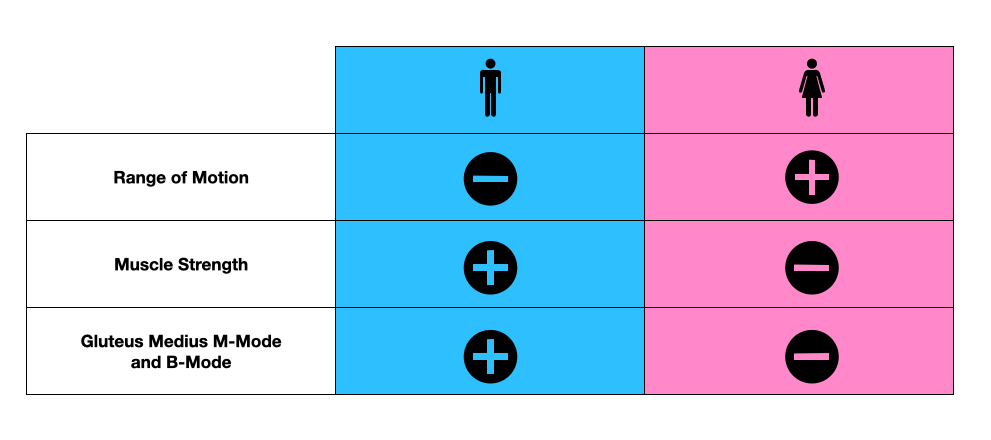Current issue
Archive
Manuscripts accepted
About the Journal
Editorial office
Editorial board
Section Editors
Abstracting and indexing
Subscription
Contact
Ethical standards and procedures
Most read articles
Instructions for authors
Article Processing Charge (APC)
Regulations of paying article processing charge (APC)
DIAGNOSTICS, LABORATORY / CLINICAL RESEARCH
The influence of gender on hip range of motion, hip muscle strength, gluteus medius thickness and M-mode ultrasound examination in asymptomatic university athletes: a cross-sectional study
1
Faculty of Sport Sciences, Universidad Europea de Madrid, Villaviciosa de Odón, Madrid, Spain
2
MVClinic Institute, Madrid, Spain
3
CEU San Pablo University, Madrid, Spain
4
Clínica CEMTRO, Madrid, Spain
Submission date: 2022-11-02
Final revision date: 2022-12-12
Acceptance date: 2023-01-05
Online publication date: 2023-05-04
KEYWORDS
TOPICS
ABSTRACT
Introduction:
Physical activity is a proposed factor in the development of hip pathologies in males and females. The main objectives of this study were to investigate the influence of gender on isometric hip muscle strength, hip range of motion and gluteus medius thickness at rest, during contraction and onset activation.
Material and methods:
A cross-sectional study was carried out. Hip range of motion, hip muscle strength and gluteus medius thickness at rest (B-mode ultrasound) and onset activation (M-mode ultrasound) were measured in thirty asymptomatic university athletes without a history of hip pain.
Results:
A total of fifteen males (30 hips) and fifteen females (30 hips) with a mean age of 22 ±6.5 and 20 ±2.75 years were recruited. Females demonstrated greater hip range of motion in flexion, abduction and internal rotation in dominant and non-dominant legs (p < 0.05) but no differences were found in extension, adduction and external rotation (p > 0.05). Furthermore, females showed less isometric hip muscle strength in hip flexion, extension, abduction, adduction, internal and external rotation (p < 0.05) but not in strength ratios (p > 0.05). In addition, female exhibited lower gluteus medius thickness at muscle contraction, smaller differences in rest-contraction thickness, but no differences were observed for rest thickness or contraction velocity.
Conclusions:
This study found that asymptomatic female athletes demonstrated greater hip flexion, abduction and internal rotation ROM, lower isometric hip muscle strength and different gluteus medius thickness and onset activation compared with asymptomatic male athletes.
Physical activity is a proposed factor in the development of hip pathologies in males and females. The main objectives of this study were to investigate the influence of gender on isometric hip muscle strength, hip range of motion and gluteus medius thickness at rest, during contraction and onset activation.
Material and methods:
A cross-sectional study was carried out. Hip range of motion, hip muscle strength and gluteus medius thickness at rest (B-mode ultrasound) and onset activation (M-mode ultrasound) were measured in thirty asymptomatic university athletes without a history of hip pain.
Results:
A total of fifteen males (30 hips) and fifteen females (30 hips) with a mean age of 22 ±6.5 and 20 ±2.75 years were recruited. Females demonstrated greater hip range of motion in flexion, abduction and internal rotation in dominant and non-dominant legs (p < 0.05) but no differences were found in extension, adduction and external rotation (p > 0.05). Furthermore, females showed less isometric hip muscle strength in hip flexion, extension, abduction, adduction, internal and external rotation (p < 0.05) but not in strength ratios (p > 0.05). In addition, female exhibited lower gluteus medius thickness at muscle contraction, smaller differences in rest-contraction thickness, but no differences were observed for rest thickness or contraction velocity.
Conclusions:
This study found that asymptomatic female athletes demonstrated greater hip flexion, abduction and internal rotation ROM, lower isometric hip muscle strength and different gluteus medius thickness and onset activation compared with asymptomatic male athletes.
Share
RELATED ARTICLE
We process personal data collected when visiting the website. The function of obtaining information about users and their behavior is carried out by voluntarily entered information in forms and saving cookies in end devices. Data, including cookies, are used to provide services, improve the user experience and to analyze the traffic in accordance with the Privacy policy. Data are also collected and processed by Google Analytics tool (more).
You can change cookies settings in your browser. Restricted use of cookies in the browser configuration may affect some functionalities of the website.
You can change cookies settings in your browser. Restricted use of cookies in the browser configuration may affect some functionalities of the website.



